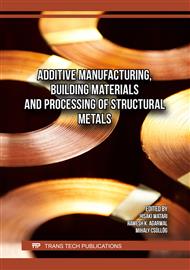[1]
Y. Kısmet and A. Dogan, "Characterization of the mechanical and thermal properties of rape short natural-fiber reinforced thermoplastic composites," Iran. Polym. J., vol. 31, no. 2, p.143–151, Feb. 2022.
DOI: 10.1007/s13726-021-00988-9
Google Scholar
[2]
C. Balaji Ayyanar et al., "Effect of natural fillers as reinforcements on mechanical and thermal properties of HDPE composites," J. Thermoplast. Compos. Mater., vol. 37, no. 2, p.800–819, Feb. 2024.
DOI: 10.1177/08927057231186312
Google Scholar
[3]
S. Khamtree, C. Srivabut, S. Khamtree, and R. Kaewmai, "Effects of Natural Fiber Waste, Content, and Coupling Agent on the Physical and Mechanical Properties of Wood Species–Plastic Composites as Green Materials," Fibers Polym., vol. 25, no. 4, p.1391–1402, Apr. 2024.
DOI: 10.1007/s12221-024-00493-9
Google Scholar
[4]
L. A. Elseify, M. Midani, A. A. El-Badawy, A.-F. M. Seyam, and M. Jawaid, "Benchmarking automotive nonwoven composites from date palm midrib and spadix fibers in comparison to commercial leaf fibers," Biomass Convers. Biorefinery, Feb. 2023.
DOI: 10.1007/s13399-023-03910-w
Google Scholar
[5]
Z. Sun, Y. Duan, H. An, X. Wang, S. Liang, and N. Li, "Research Progress and Application of Natural Fiber Composites," J. Nat. Fibers, vol. 20, no. 2, p.2206591, Aug. 2023.
DOI: 10.1080/15440478.2023.2206591
Google Scholar
[6]
A. B. M. Supian et al., "Mechanical and physical performance of date palm/bamboo fibre reinforced epoxy hybrid composites," J. Mater. Res. Technol., vol. 15, p.1330–1341, Nov. 2021.
DOI: 10.1016/j.jmrt.2021.08.115
Google Scholar
[7]
F. AL-Oqla, S. Sapuan, and O. Fares, "Electrical–Based Applications of Natural Fiber Vinyl Polymer Composites," in Natural Fibre Reinforced Vinyl Ester and Vinyl Polymer Composites, 2018, p.349–367.
DOI: 10.1016/B978-0-08-102160-6.00018-4
Google Scholar
[8]
H. M. Hamada, J. Shi, M. S. Al Jawahery, A. Majdi, S. T. Yousif, and G. Kaplan, "Application of natural fibres in cement concrete: A critical review," Mater. Today Commun., vol. 35, p.105833, Jun. 2023.
DOI: 10.1016/j.mtcomm.2023.105833
Google Scholar
[9]
I. Shah, J. Li, S. Yang, Y. Zhang, and A. Anwar, "Experimental Investigation on the Mechanical Properties of Natural Fiber Reinforced Concrete," J. Renew. Mater., vol. 10, p.1307–1320, Dec. 2021.
DOI: 10.32604/jrm.2022.017513
Google Scholar
[10]
E. Kuoribo, H. Shokry, A. H. Hassanin, T. Asawa, and H. Mahmoud, "Optimizing concrete performance: An investigation into the impact of supplementary cementitious materials and sand particle sizes," Mater. Lett., vol. 347, p.134593, Sep. 2023.
DOI: 10.1016/j.matlet.2023.134593
Google Scholar
[11]
T. V. Nagaraju and A. Bahrami, "Development of Sustainable Concrete Using Treated Bamboo Reinforcement," in Sustainable Structures and Buildings, A. Bahrami, Ed., Cham: Springer International Publishing, 2024, p.39–49.
DOI: 10.1007/978-3-031-46688-5_3
Google Scholar
[12]
T. V. Nagaraju and A. Bahrami, "Sustainable Geopolymer Bricks Manufacturing Using Rice Husk Ash: An Alternative to Fired Clay Bricks," in Sustainable Structures and Buildings, A. Bahrami, Ed., Cham: Springer International Publishing, 2024, p.65–75.
DOI: 10.1007/978-3-031-46688-5_5
Google Scholar
[13]
E. Kuoribo, H. Shokry, A. Hassanein, T. Asawa, and H. Mahmoud, "Fabrication of energy-efficient cement panels from construction waste for sustainable building application," Archit. Eng. Des. Manag., vol. 0, no. 0, p.1–23, 2023.
DOI: 10.1080/17452007.2023.2195613
Google Scholar
[14]
S. Bhopatrao and S. Kewate, "Manufacturing of sustainable manhole covers designed for pedestrian networks," AIP Conf. Proc., vol. 3006, no. 1, p.030001, Dec. 2023.
DOI: 10.1063/5.0189456
Google Scholar
[15]
A. Merzoug, B. Bouhamida, Z. Sereir, A. Bezazi, A. Kilic, and Z. Candan, "Quasi-static and dynamic mechanical thermal performance of date palm/glass fiber hybrid composites," J. Ind. Text., vol. 51, no. 5_suppl, pp. 7599S-7621S, Jun. 2022.
DOI: 10.1177/1528083720958036
Google Scholar
[16]
Md. Z. Islam, E. C. Sabir, and Md. Syduzzaman, "Experimental investigation of mechanical properties of jute/hemp fibers reinforced hybrid polyester composites," SPE Polym., vol. 5, no. 2, p.192–205, 2024.
DOI: 10.1002/pls2.10119
Google Scholar
[17]
S. M. Ahmad, G. M C, M. Shettar, and S. Sharma, "Experimental investigation of mechanical properties and morphology of bamboo-glass fiber-nanoclay reinforced epoxy hybrid composites," Cogent Eng., vol. 10, no. 2, p.2279209, Dec. 2023.
DOI: 10.1080/23311916.2023.2279209
Google Scholar


